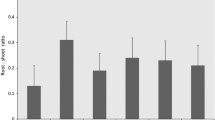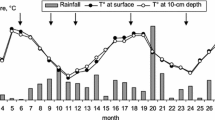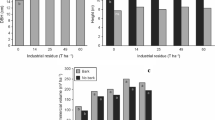Abstract
The Brazil nut tree (Bertholletia excelsa) is a frequent component of agroforestry systems in the Amazon because of its adaptation to nutrient-poor upland soils and multiple uses. We investigated the aboveground biomass production (kg dry weight), nutrient uptake and requirements (N, P, Ca, Mg, K) of Brazil nut trees of different sizes grown under agroforestry conditions and fertilized at different levels. Eight of 70 experimental trees with different size were harvested and stem, branches and leaves were separated. Nutrient contents were determined for three trees of varying size. Average tree growth was fast, but variability was high, suggesting considerable potential for the improvement of this economically important species. The trees responded to increased levels of fertilizer and lime with significantly increased foliar nutrient contents and growth, probably because of the improved availability of Mg and Ca for which the species seems to have a relatively high demand. In contrast to Brazil nut trees grown in forest or dense plantations, the agroforestry trees invested a substantial part of their biomass and nutrients in large branches and developed spreading crowns. To improve stem form, reduce competition with associated crops for light and recycle nutrients, regular pruning of lower branches or planting arrangements that favor self-pruning are recommended. These measures would also increase the recycling of Ca and Mg, large quantities of which are contained in the branches.




Similar content being viewed by others
References
Buckley DP, O’Malley DM, Apsit V, Prance GT, Bawa KS (1988) Genetics of Brazil nut (Bertholletia excelsa Humb. & Bonpl.: Lecythidaceae). Theor Appl Genet 76:923–928
Cavalcante PB (1991) Frutas Comestíveis da Amazônia (Edible Fruits of the Amazon). Museu Goeldi, Belém, p 279
Dinkelmeyer H, Lehmann J, Kaiser K, Teixeira WG, Renck A, Zech W (2000) Fate of applied N fertilizer in mixed cropping systems in the central Amazon. III Congresso Brasileiro de Sistemas Agroflorestais. Embrapa, Manaus, pp 196–197
FAO (1986) Food and fruit-bearing forest species, 3rd edn. Food and Agriculture Organization of the United Nations, Rome, p 308
Fernandes ECM, Davey CB, Nelson LA (1993) Alley cropping on an acid soil in the upper Amazon: mulch, fertilizer, and hedgerow root pruning effects. In: Ragland J, Lal R (eds) Technologies for sustainable agriculture in the tropics. American Society of Agronomy, Madison, pp 77–96
Fernandes ECM, Perin R, Wandelli E, Souza SG, Matos JC, Arco-Verde M, Ludewigs T, Neves A (1999) Agroforestry systems to rehabilitate abandoned pastureland in the Brazilian Amazon. In: Jiménez F, Beer J (eds) International symposium on multi-strata agroforestry systems with perennial crop. CATIE, Turrialba, pp 24–26
Little TM, Hills FJ (1978) Agricultural experimentation. Wiley, New York, p 350
Nepstad DC, Uhl C, Serrão EAS (1991) Recuperation of a degraded Amazonian landscape: forest recovery and agricultural restoration. Ambio 20:248–255
Novozamsky I, Houba VJG, van Eck R, van Vark W (1983) A novel digestion technique for multi-element plant analysis. Commun Soil Sci Plant Anal 14:239–248
Pereira HS (2000) Castanhais nativos: um caso de domesticação incidental de uma éspecie dominante do dossel de floresta tropical. III Congresso Brasileiro de Sistemas Agroflorestais. Embrapa, Manaus, pp 353–356
Pereira AP, Graca MAS, Molles M (1998) Leaf litter decomposition in relation to litter physico-chemical properties, fungal biomass, arthropod colonization, and geographical origin of plant species. Pedobiologia 42:316–327
Peres CA, Baider C, Zuidema PA (2003) Demographic threats to the sustainability of Brazil nut exploitation. Science 302:2112–2114
Schroth G, da Silva LF, Seixas R, Teixeira WG, Macêdo JLV, Zech W (1999) Subsoil accumulation of mineral nitrogen under polyculture and monoculture plantations, fallow and primary forest in a ferralitic Amazonian upland soil. Agric Ecosyst Environ 75:109–120. doi:10.1016/S0167-8809(99)00068-7
Schroth G, Seixas R, da Silva LF, Teixeira WG, Zech W (2000a) Nutrient concentrations and acidity in ferralitic soil under perennial cropping, fallow and primary forest in central Amazonia. Eur J Soil Sci 51:219–231
Schroth G, Teixeira WG, Seixas R, da Silva LF, Schaller M, Macêdo JLV, Zech W (2000b) Effect of five tree crops and a cover crop in multi-strata agroforestry at two fertilization levels on soil fertility and soil solution chemistry in central Amazonia. Plant Soil 221:143–156
Schroth G, Elias MEA, Uguen K, Zech W (2001a) Nutrient fluxes in rainfall, throughfall and stemflow in tree-based land use systems and spontaneous tree vegetation of central Amazonia. Agric Ecosyst Environ 87:37–49
Schroth G, Salazar E, da Silva JP Jr (2001b) Soil nitrogen mineralization under tree crops and a legume cover crop in multi-strata agroforestry in central Amazonia: spatial and temporal patterns. Exp Agric 37:253–267
Schroth G, D’Angelo SA, Teixeira WG, Haag D, Lieberei R (2002) Conversion of secondary forest into agroforestry and monoculture plantations in Amazonia: consequences for biomass, litter and soil carbon stocks after 7 years. For Ecol Manage 163:131–150. doi:10.1016/S0378-1127(01)00537-0
Scoles R, Gribel R (2011) Population structure of Brazil nut (Bertholletia excelsa, Lecythidaceae) stands in two areas with different occupation histories in the Brazilian Amazon. Hum Ecol 39:455–464
Smith NJH (1996) Home gardens as a springboard for agroforestry development in Amazonia. Int Tree Crops J 9:11–30
Tran TS, Simard RR (1993) Mehlich III-extractable elements. In: Carter MR (ed) Soil sampling and methods of analysis. Lewis Publishers, Boca Raton, pp 43–49
Acknowledgments
Sammya Agra D’Angelo helped in the field work. J. Ferraz made valuable comments on an earlier version of the text.
Author information
Authors and Affiliations
Corresponding author
Additional information
Project funding: This research was funded by the German Ministry of Education and Research (BMBF) and the Brazilian Conselho National de Desenvolvimento Científico e Tecnológico (CNPq).
The online version is available at http://www.springerlink.com
Rights and permissions
About this article
Cite this article
Schroth, G., da Mota, M.S.S. & de Assis Elias, M.E. Growth and nutrient accumulation of Brazil nut trees (Bertholletia excelsa) in agroforestry at different fertilizer levels. J. For. Res. 26, 347–353 (2015). https://doi.org/10.1007/s11676-015-0037-9
Received:
Accepted:
Published:
Issue Date:
DOI: https://doi.org/10.1007/s11676-015-0037-9




